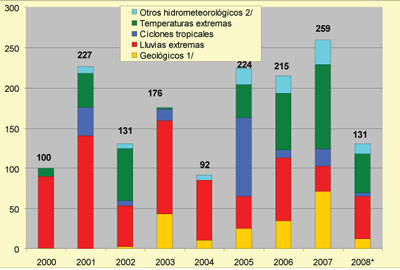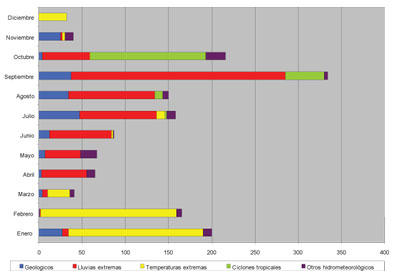Socioeconomic Assessment of Disasters in Mexico: A tool for risk management
Since time immemorial, disasters, whether of natural origen or manmade, have had a great impact on the history of humanity and represent one of the greatest latent threats we face. According to the Economic Commission for Latin America and the Caribbean (ECLAC), a disaster is “an event, usually sudden and unexpected, which causes damage, losses and temporary breakdown of activities in a given area, affecting a substantial part of the population.” What are often referred to as 'natural disasters' are those related to the occurrence of geodynamic, hydrological, atmospheric or biological phenomena; while anthropogenic disasters refer to events related to technology, human processes or pollution.
Knowing the incidence and impact of disasters leads to the development of public policies that contribute to mitigating the socioeconomic effects of these phenomena. Therefore, for over 25 years the United Nations (UN) —through ECLAC— has been developing and using a methodology for assessing these adverse effects.1 Different assessments have been conducted using this methodology that give an account of the losses and damage caused by extreme natural phenomena in Latin American and Caribbean countries.
Since ECLAC only conducts socioeconomic assessments upon government request and these only analyze a specific event, the true magnitude of human and material harm that disasters cause every year is not accurately known in any country. For this reason, the National Center for Disaster Prevention (CENAPRED) in Mexico has been conducting an annual national disaster assessment based on the ECLAC methodology since 1999.
The results of these efforts have been published in a series titled Características e impacto socioeconómico de los principales desastres en la República Mexicana [Characteristics and Socioeconomic Impacts of Major Disasters in the Republic of Mexico], of which there are ten volumes thus far. This compendium, in addition to offering information on the history of disasters in this country, includes statistics on the human and economic losses caused by these phenomena. It also collects experiences from each region on emergency response and describes the characteristics of each disaster.
It is worth mentioning that these studies not only document the most significant disasters—such as the 1985 earthquake in Mexico City— but they also list medium- and small-scale events, which end up causing greater suffering on the whole.

Figura 1. Muertes por tipo de fenómeno 2000-2008
To give an example, in 2008, no large-scale disasters were recorded —no events similar to the flooding that occurred in Hidalgo, Puebla, Veracruz and Tabasco in 1999; Tropical cyclone Isidore in 2002; Hurricanes Emily, Stan and Wilma in 2005; or the flooding in Tabasco in 2007. However, some 30 localized catastrophes were recorded, and the damage they caused amounted to more than 100 million Mexican pesos each. Thus, the cost in damages was around US$1.2 billion, making 2008 the third worst year for economic losses that Mexico has suffered in the last decade, as a result of disasters caused by hydro-meteorological events.
This important body of knowledge enables comparative analyses of the socioeconomic impacts caused by the most recent disasters and those that occurred decades earlier. For example, during the period between1980 and1999, natural disasters caused, on average, 506 casualties and US$701 million in damages per year; while in the last nine years (2000-2008), the number of deaths dropped to 176 per year, but economic losses essentially tripled.
This drop in the number of victims results from the development of the Tropical Cyclone Early Warning System (SIAT-CT) in 2000. But the increase in losses and damage possibly stems from two factors in particular: an increased level of exposed infrastructure and facilities, and the increased intensity and incidence of natural phenomena as a result of climate change

Figura 2. Muertes por tipo de fenómeno 2000-2008
Another of the advantages of having systematic records of the impacts of disasters is that it enables to identify which events affect certain sectors more than others. For example, it has been observed that agriculture is one of the sectors more exposed to the impact of tropical cyclones, due to the strong winds and to the amount of water, which cause losses in thousands of hectares of different crops. Likewise, floods in urban areas have a recurring impact on housing, as well as on communications and transportation infrastructure.
A retrospective analysis of the deaths caused by disasters in the last nine years showed that the greatest number of casualties was caused by hydro meteorological events, chiefly torrential rains and extreme temperatures (Figure 1). Likewise, it was observed that, historically, the months of September and October are the ones with the highest recorded rates of deaths, due to the occurrence of tropical cyclones and extreme rainfall.
In Mexico, the disasters that have impacted the most are the 1985 earthquakes, which caused at least 6,000 deaths and losses that amounted to thousands of millions of pesos. The flooding in Tabasco in 2007 is considered the second most expensive disaster in recent Mexican history. Fortunately, these events did not take a toll on lives because of the advances in the area in civil protection, both regarding prevention and emergency response.
Another of the advantages of keeping systematic records of the impacts caused by disasters is to identify which events affect certain sectors more than others. For example, through the years, it has been seen that the agricultural sector is one of the most exposed to the impact of tropical cyclones, due to the strong winds and enormous quantities of water that cause losses in thousands of hectares of different crops. Likewise, floods in urban areas have a recurring impact on housing as well as on communications and transportation infrastructure.
Governments in the different countries must understand that the socioeconomic assessment of disasters is a basic tool for:
- Developing specific support mechanisms or funds in the event of disasters;
- Identifying the most vulnerable sectors that need greater support in case of a disaster;
- Planning and improving policies aimed at disaster prevention and at the creation of tools that enable transferring the cost of disasters to third parties, whether through insurers, private investments, or even the public sector;
- Determining the capacity of a State or region for carrying out reconstruction efforts and establishing priorities;
- Accurately calculating the minimum requirements for obtaining the financial aid needed;
- Channeling aid to the most affected sectors, and distributing it among the affected population;
- Developing a databank by type of disaster and region affected. In the medium term, the databank will enable users to determine the most vulnerable regions in the country to certain types of phenomena; and
- Implementing prevention measures, taking into account the cost-benefit ratio.
Karla M. Méndez Estrada
National Center for Disaster Prevention
Researcher, Area of Social and Economic Studies
karla@cenapred.unam.mx
Rafael Marín Cambranis
National Center for Disaster Prevention
Researcher, Area of Social and Economic Studies
rafael@cenapred.unam.mx





